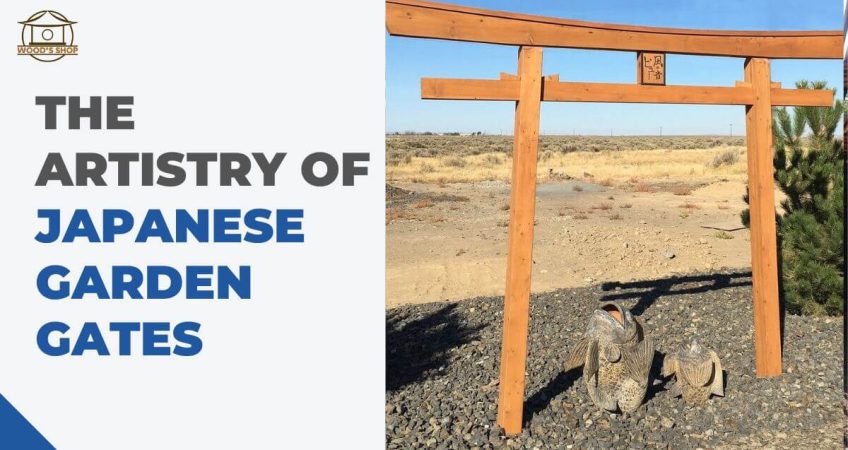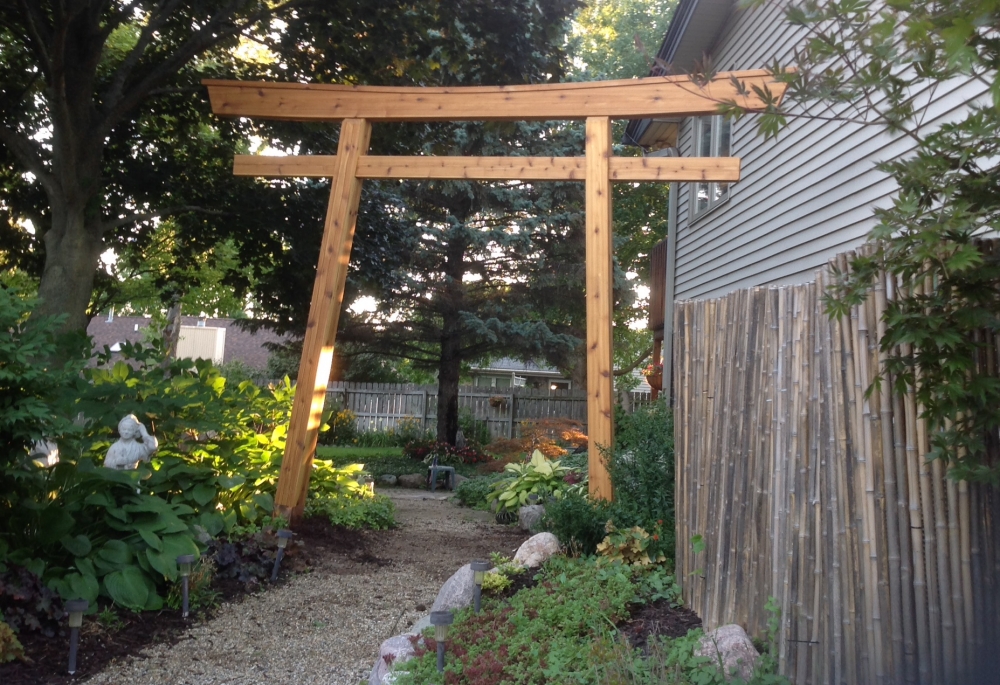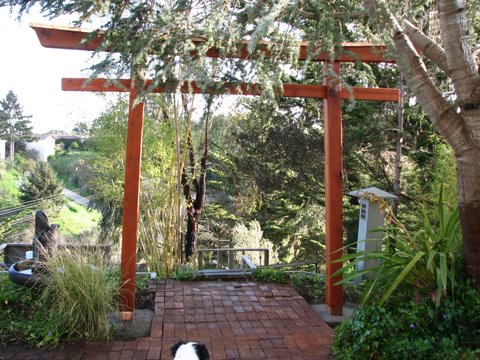Secrets of Tranquility: The Artistry of Japanese Garden Gates

Japanese garden gates, or “torii,” are more than mere entryways; they are pivotal elements symbolizing tranquility and serenity. These gates invite visitors into a realm where nature and artistry harmonize, creating an atmosphere of peace and calm. With their distinct design, rooted in centuries-old traditions, they serve as a profound expression of Japanese culture and aesthetics.
The simplicity of their structure, juxtaposed against the complex symbolism they embody, reflects the underlying Zen principles of harmony, respect, purity, and tranquility that permeate the design of Japanese gardens.
The History of Japanese Garden Gates
The origins of Japanese garden gates, or “torii,” trace back to the ancient Shinto tradition where they served as sacred markers separating the earthly realm from the divine. Initially, these gates were simple and unadorned, mirroring the fundamental Shinto belief in the natural world’s sanctity.
However, over the centuries, as Buddhism permeated into Japan, the design and styles of these gates evolved, influenced by Buddhist architectural aesthetics. The gates became more elaborate, featuring intricate carvings and often painted in vibrant red, signifying protection and prosperity.
Despite these changes, the essence of tranquility and harmony that these gates symbolize remained unchanged, reflecting a seamless blend of spiritual traditions and artistic evolution.
Symbolism and Spiritual Significance
Japanese garden gates, notably the torii and moon gates, are imbued with profound symbolism that transcends mere aesthetic appeal. The torii gates, typically painted in a vibrant vermilion hue, signify the transition from the mundane world to a sacred space, inviting visitors to disconnect from their everyday worries and immerse in the serenity of the garden.
The moon gates, characterized by their circular or semi-circular shape, symbolize the cyclical nature of life and the interconnectedness of all things. When positioned correctly, these gates frame the garden’s elements, such as a carefully pruned tree or a distant mountain, akin to a living painting, enhancing the experience of the viewer.
Spiritually, these gates play a significant role in establishing a harmonious environment within the garden. Just as the gate serves as a threshold for entering a physical space, it also serves as a metaphor for psychological transition, encouraging visitors to shift their mindset, let go of stress, and embrace tranquility.
This symbolic and spiritual importance of the gates is an integral part of the artistry and ethos of Japanese gardens, further enriching their tranquility and aesthetic appeal.

Design and Construction
The architectural design of Japanese garden gates is a testament to the Japanese ethos of craftsmanship and attention to detail. Each gate, whether a grand torii or a discreet moon gate, is meticulously crafted to not merely serve its function but to blend seamlessly with the garden’s overall aesthetic.
Commonly used materials in constructing these gates include wood, stone, and sometimes metal. Wood, often left in its natural state or painted in the characteristic vermilion, is preferred for its organic feel and ability to harmonize with the natural surroundings. Stone, on the other hand, is typically used for more robust and permanent structures, reflecting strength and longevity. Metal is rarely used, and when it is, it’s usually for ornamental details, such as hinges or crests.
The design of these gates often incorporates symbolic elements. For instance, the crossbeam on a torii gate might be curved upwards at the ends, mimicking the wings of a bird in flight, symbolizing freedom and ascension. The moon gates, with their circular or semi-circular design, subtly represent the cycle of life, bringing a sense of rhythm and continuity to the garden.
Crafting these gates requires immense skill and precision. Each element, from the selection and treatment of materials to the exact positioning and alignment of the gate within the garden, is thoughtfully considered. This meticulous attention to detail, combined with a deep understanding of symbolism and aesthetics, ensures that each gate is not just a physical structure but a profound artistic statement within the garden’s tranquil landscape.
Types of Japanese Garden Gates
There are several types of Japanese garden gates, each with its unique characteristics and purposes, contributing to the overall tranquility of the garden.
Torii Gates
The most recognizable type of Japanese garden gate is the Torii. Traditionally painted in a vibrant vermilion hue, these gates are a prominent feature in Shinto shrines, marking the transition from the mundane to the sacred. A Torii gate often consists of two upright posts and two crossbars, with the top crossbar often curved upward at the ends. The Torii gate embodies the essence of Japanese aesthetics and philosophy, symbolizing the boundary between the physical and spiritual world.
Moon Gates
Moon gates, characterized by their circular or semi-circular shape, are another common feature in Japanese gardens. These gates serve both a functional and symbolic role, marking entrances and exits within the garden, and representing the cyclical nature of life. A moon gate, carefully positioned, can frame a particular view of the garden, enhancing its aesthetic appeal and creating a ‘living painting’ effect.
Yakuimon Gates
Yakuimon gates, typically found in Buddhist temples, are more elaborate and intricately designed. These gates often feature a gabled roof and are made from high-quality timber. The Yakuimon gate is a symbol of protection, guarding the temple or garden’s sanctity from the outside world.
Each of these gate types, with their distinct design and symbolism, contribute to the tranquil ambiance of a Japanese garden, leading visitors on a journey of serenity and introspection.
Read more about The Zen of Japanese Arbors.
The Role of Japanese Garden Gates
The role of Japanese garden gates extends beyond their physical presence in the garden. They significantly enhance the overall aesthetics, creating a sense of balance, harmony, and rhythm within the landscape. Each gate style, whether it’s the vibrant Torii, the subtle Moon gate, or the intricate Yakuimon, contributes uniquely to the garden’s aesthetic appeal. The careful positioning of these gates, their design that often frames a picturesque view of the garden, and their symbolic representation, all contribute to creating a captivating visual experience for the visitors.
Functionally, these gates establish a sense of transition, guiding visitors as they navigate through the garden. The Torii gate, with its distinctive design, creates a clear demarcation between the mundane and the sacred, prompting visitors to mentally prepare themselves as they step into the serene environment of the garden. Similarly, the Moon gate and the Yakuimon gate, with their symbolic representations, signify the cyclical nature of life and the essence of protection and sanctity, respectively. This sense of transition, further reinforced by the symbolic elements, fosters a deeper connection with nature and a sense of inner peace.
In essence, Japanese garden gates, with their unique design, symbolic significance, and functionality, play a pivotal role in enhancing the overall aesthetics of the garden and establishing a sense of harmony, tranquility, and spiritual connection with the natural surroundings.
Modern Interpretations
Japanese garden gates continue to inspire contemporary garden designs worldwide due to their intricate craftsmanship, profound symbolism, and seamless blending with nature. Modern architects often incorporate these traditional elements into their designs, creating a fusion of tradition and modernity.
For instance, the Torii gate’s distinctive design has been adapted in many contemporary gardens, still serving as a symbolic transition from the mundane to the serene. However, you may find variations in material and color, with some modern Torii gates made of metal or sleek, painted wood, reflecting a more contemporary aesthetic.
Moon gates have found their place in landscape designs beyond just Japanese gardens. Their circular design is often used to frame a picturesque view within a garden or serve as an enchanting entrance to a secluded garden space. Modern interpretations may see these gates constructed out of a variety of materials, such as steel or concrete, and presented in minimalist or abstract designs.
Yakuimon gates too have inspired modern architects. While preserving the traditional gabled roof design, contemporary versions might be simplified, maintaining clean lines and minimalist aesthetics. Furthermore, they are often used in settings that aim to create a tranquil, zen-like ambiance, such as meditation centers, spas, and modern residential gardens.

Despite the changes in material choice, color, and design simplification, the underlying philosophy of these gates as a transition point, and their symbolic meanings, remain central in their modern adaptations. These transformations are proof of the timeless beauty and relevance of Japanese garden gates in contemporary landscape design and a testament to their enduring appeal.
Appreciating the Artistry
When visiting a Japanese garden, take time to admire the artistry of each gate. Notice the meticulous craftsmanship, the thoughtful placement, and the profound symbolism they carry. Observe the balance and harmony they bring to the garden, appreciating how each element complements the other. To truly appreciate these gates’ artistry, take a moment to contemplate on their symbolic meaning. Allow yourself to experience the transition from the mundane to the sacred as you pass through a Torii gate, contemplate the cyclical nature of life when looking through a Moon gate, or feel a sense of protection and sanctity beneath the Yakuimon gate.
Consider incorporating elements of Japanese garden gate design into your own landscape. Even if you can’t replicate the traditional gate styles in their entirety, you can take inspiration from their symbolic meanings. For instance, you can create a feeling of transition in your garden by placing a gate or an archway at the entrance. You can use the circular design of the Moon gate as a framing element to highlight a specific view or feature in your garden. By bringing elements of these timeless designs into your garden, you can create your own sanctuary of peace and tranquility, reflecting the serene ambiance of traditional Japanese gardens.
Read more about DIY Wood Gazebo.
Conclusion
Japanese garden gates, with their intricate design, symbolic resonance, and inherent functionality, stand as timeless symbols of tranquility and harmony. These structures, skillfully crafted and thoughtfully positioned, extend an invitation to introspection and a deeper connection with nature, reinforcing the serene ambiance of the garden. Their enduring allure lies in their ability to transcend time and cultures, finding relevance and adaptation in modern landscaping worldwide.
As you immerse yourself in the beauty and tranquility of these gardens, we encourage you to take a moment to appreciate the artistry of the gates, understanding their symbolism, and experiencing the transition they facilitate. In your own landscapes, consider incorporating elements of these timeless designs, creating your personal oasis of peace and tranquility. For authentic and quality Japanese garden gates, do not hesitate to visit Wood’s Shop, where traditional craftsmanship meets modern design sensibilities.
FAQs
Q1: What are the three types of Japanese garden gates mentioned in the article and what does each symbolize?
The article mentions three types of Japanese garden gates: Torii, Moon, and Yakuimon gates. The Torii gate symbolizes a transition from the mundane to the sacred. The Moon gate represents the cyclical nature of life. The Yakuimon gate signifies protection and sanctity.
Q2: How have Japanese garden gates influenced modern landscape design?
Japanese garden gates have heavily influenced modern landscape design. Their unique design and profound symbolism have been adapted into contemporary gardens worldwide, with variations in material and color reflecting modern aesthetics. Despite these changes, the underlying philosophy and symbolism of these gates remain central to their design.
Q3: How can one incorporate elements of Japanese garden gate design into their own landscape?
Even without replicating the traditional gate styles entirely, elements of their design can be incorporated into your own landscape. For example, creating a sense of transition with a gate or archway at the entrance, or using the circular design of the Moon gate to highlight a specific view in your garden. These elements can help create a personal sanctuary of peace and tranquility.